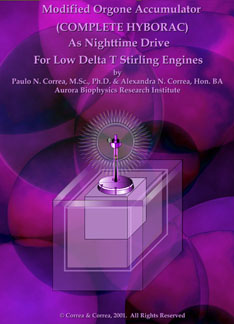![Akronos logo]](/images/akronos_wheel.jpg)
|
Akronos Publishing Concord, ON, Canada www.aetherometry.com |
![Akronos logo]](/images/akronos_wheel.jpg)
|
Akronos Publishing Concord, ON, Canada www.aetherometry.com |

Modified Orgone accumulator (complete HYBORAC) as nighttime drive for
low delta T Stirling Engines
by Correa, Paulo N. & Correa, Alexandra N.
Published in January 2002. 23 pages.
Experimental Aetherometry, Vol. 4
Monograph AS2-26
Price: US $25 ($20 ISFA)
See also the two companion reports: AS2-25 and AS2-32.
|
ABSTRACT
In the first report of this two-part series, we demonstrated that it was possible to drive low delta T Stirling engines of the MM6 type from the solar- sourced anomalous To-T difference registered in modified Orgone Accumulators referred to as HYBORACs, partly composed of a matte black-painted ORAC and Faraday cage. The design optimized response to solar radiation as well as heat retention, yielding motor speeds up to 140 rpm with delta T's on the order of 21°C. In the present report, our focus lies in maximizing the HYBORAC structure so that it can sustain outdoor operation not just when exposed directly to atmosphere- filtered solar radiation, but above all during the nighttime hours when the device cools together with the cooling air and in the absence of solar radiation. It should be noted that this is not simply a problem of maintaining a positive temperature difference (To-T), since the motor action continually pumps sensible heat out from the HYBORAC. But by increasing the retention of heat, we can also maximize utilization of the sensible heat being generated from other energy conversions occurring inside ORACs. The solution lay in an arrangement that employs both the HYBORAC and inverted BORACs as components of a more traditional ORAC arrangement, into which they can be inserted. With this improved combination - referred to as the 'complete HYBORAC' - we were able to achieve speeds of 150 rpm during daytime (with delta T values reaching 22.5°C), and speeds of 30 to 80 rpm during nighttime (with delta T values of 3.1 to 9°C). Maximum duration of Stirling Motor operation with the complete HYBORAC was 399 minutes (nearly seven hours), frost effectively bringing the motor to a halt even in the presence of a suitable delta T value (3.5°C). The To-T values measured at the top plate of the complete HYBORAC reached 32°C during daytime, with delta T recovery efficiencies of 65 to 86%, whereas nighttime To-T values exceeded delta T by no more than 2°C, and when they became smaller than the delta T (with recovery efficiencies greater than 100%),the motor began to exhaust heat generation inside the complete HYBORAC. From that point until it stopped, nearly two hours elapsed. |